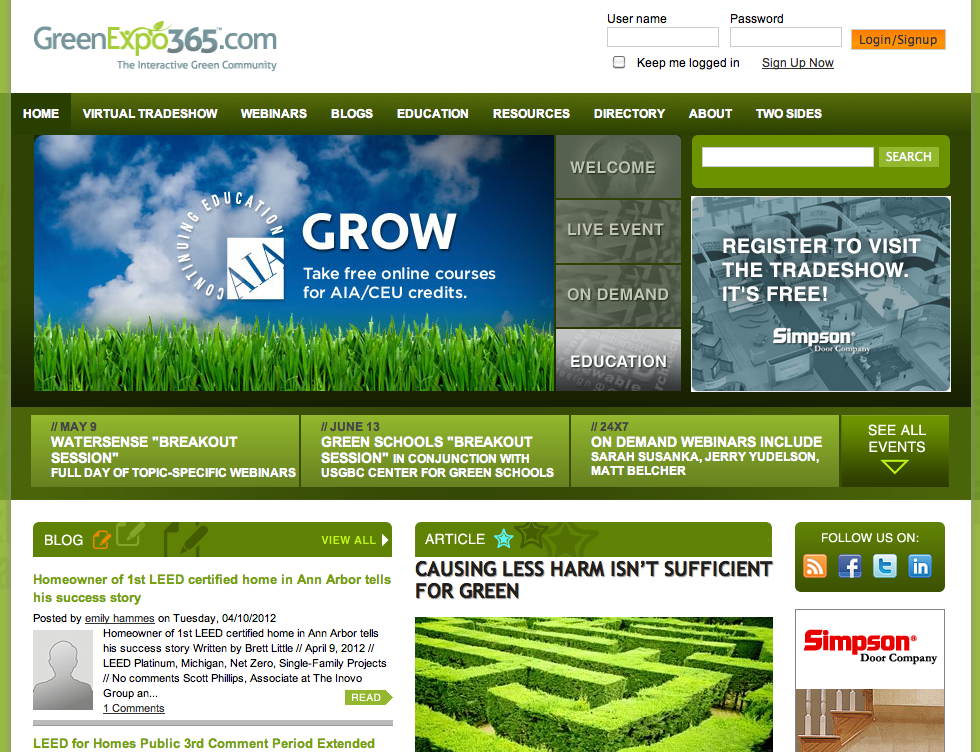The U.S. Environmental Protection Agency (EPA) estimates that at least 36 states will face water shortages by 2013. It’s a problem not limited to the desert Southwest, but stretches to the Midwest, Florida, Georgia and other regions. The EPA’s WaterSense program is designed to decrease indoor and outdoor nonagricultural water use through more efficient products, equipment and programs.
Architects and builders interested in developing more water-efficient buildings can learn the ins-and-outs of the WaterSense program during a series of four free live webinars hosted online at GreenExpo365.com May 9.
Experts from the EPA, along with architects and builders will present ways to design and build water-conscious homes and buildings, and be available to answer questions.
The presentation schedule is:
- Wednesday, May 9, 8:00 a.m. Pacific / 11:00 a.m. Eastern ?Jonah Schein, EPA WaterSense Program Technical & Certification Coordinator for New Homes: “Design Leads the Way: Why and How Architects Should Design with Water in Mind”
- Wednesday, May 9, 9:30 a.m. Pacific / 12:30 p.m. Eastern ?Alicia Marrs, EPA WaterSense Program New Homes Partnerships Marketing & Outreach Specialist: “Talk it Up! Communicating the Value of a Water Efficient Home”
- Wednesday, May 9, 11:00 a.m. Pacific / 2:00 p.m. Eastern ?Amber Lefstead, EPA Water Sense Program Outdoor Coordinator, and Tamara Mittman, EPA Office of Wastewater Management Environmental Engineer: “Water Conservation in the Great Outdoors – Thinking about Landscaping in a New Way”
- Wednesday, May 9, 1:00 p.m. Pacific / 4:00 p.m. Eastern ?Matt Stevens, Green Zone Home; CR Herro, Meritage Homes, Vice President of Environmental Affairs; and Jonah Schein, EPA WaterSense Program: “WaterSense in Action: Tips and Examples from an Architect, a Builder and a Verifier”
All sessions are free to attend. For more information, visit http://www.greenexpo365.com/en/about/events/upcoming_events_news_feed/may-9-watersense-breakout-session---full-day-educa_h05s6ise.html. BD+C
Related Stories
| Nov 9, 2010
Designing a library? Don’t focus on books
How do you design a library when print books are no longer its core business? Turn them into massive study halls. That’s what designers did at the University of Amsterdam, where they transformed the existing 27,000-sf library into a study center—without any visible books. About 2,000 students visit the facility daily and encounter workspaces instead of stacks.
| Nov 9, 2010
Turner Construction report: Green buildings still on the agenda
Green buildings continue to be on the agenda for real estate owners, developers, and corporate owner-occupants, according to the Turner 2010 Green Building Market Barometer. Key findings: Almost 90% of respondents said it was extremely or very likely they would incorporate energy-efficiency improvements in their new construction or renovation project, and 60% expected to incorporate improvements to water efficiency, indoor environmental quality, and green materials.
| Nov 5, 2010
New Millennium’s Gary Heasley on BIM, LEED, and the nonresidential market
Gary Heasley, president of New Millennium Building Systems, Fort Wayne, Ind., and EVP of its parent company, Steel Dynamics, Inc., tells BD+C’s Robert Cassidy about the Steel Joist Manufacturer’s westward expansion, its push to create BIM tools for its products, LEED, and the outlook for the nonresidential construction market.
| Nov 3, 2010
First of three green labs opens at Iowa State University
Designed by ZGF Architects, in association with OPN Architects, the Biorenewable Research Laboratory on the Ames campus of Iowa State University is the first of three projects completed as part of the school’s Biorenewables Complex. The 71,800-sf LEED Gold project is one of three wings that will make up the 210,000-sf complex.
| Nov 3, 2010
Park’s green education center a lesson in sustainability
The new Cantigny Outdoor Education Center, located within the 500-acre Cantigny Park in Wheaton, Ill., earned LEED Silver. Designed by DLA Architects, the 3,100-sf multipurpose center will serve patrons of the park’s golf courses, museums, and display garden, one of the largest such gardens in the Midwest.
| Nov 3, 2010
Public works complex gets eco-friendly addition
The renovation and expansion of the public works operations facility in Wilmette, Ill., including a 5,000-sf addition that houses administrative and engineering offices, locker rooms, and a lunch room/meeting room, is seeking LEED Gold certification.
| Nov 3, 2010
Sailing center sets course for energy efficiency, sustainability
The Milwaukee (Wis.) Community Sailing Center’s new facility on Lake Michigan counts a geothermal heating and cooling system among its sustainable features. The facility was designed for the nonprofit instructional sailing organization with energy efficiency and low operating costs in mind.
| Nov 3, 2010
Seattle University’s expanded library trying for LEED Gold
Pfeiffer Partners Architects, in collaboration with Mithun Architects, programmed, planned, and designed the $55 million renovation and expansion of Lemieux Library and McGoldrick Learning Commons at Seattle University. The LEED-Gold-designed facility’s green features include daylighting, sustainable and recycled materials, and a rain garden.
| Nov 3, 2010
Recreation center targets student health, earns LEED Platinum
Not only is the student recreation center at the University of Arizona, Tucson, the hub of student life but its new 54,000-sf addition is also super-green, having recently attained LEED Platinum certification.
| Nov 3, 2010
New church in Connecticut will serve a growing congregation
Tocci Building Companies will start digging next June for the Black Rock Congregational Church in Fairfield, Conn. Designed by Wiles Architects, the 103,000-sf multiuse facility will feature a 900-person worship center with tiered stadium seating, a children’s worship center, a chapel, an auditorium, a gymnasium, educational space, administrative offices, commercial kitchen, and a welcome center with library and lounge.
















